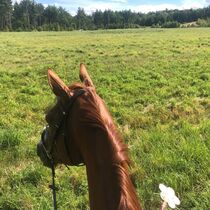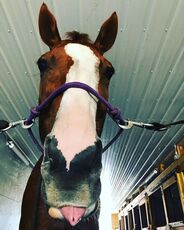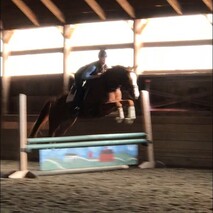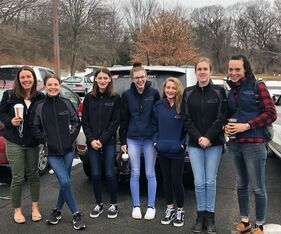For the past year, the relationship I have developed with my red mare has evolved more than the past 5 combined. It started last winter when I spent countless circles panic-galloping while she cried it out and learned to settle herself. This concept of teaching her to self soothe was a massive turning point in not only her processing but also in how I approached situations with her and also other horses. (I’ll try to sit down and give this method its own post) Before this approach, I constantly was trying to keep the lid on her anxiety and survive most situations by TELLING her she was okay instead of teaching her to decide that she could handle it on her own. In my defense, I really was just hoping to survive because as you know… this red mare is a true believer in react first, think second. She was like riding a pot of milk you were trying to get to boil. One second you’re not hot enough and the next you’re having to turn the burner off because the milk is all over the stove. So, when Tik explained that she needed to feel ok with seeing the world and get good at bringing her own anxiety back under boiling point things really started to fall into place. Now, almost exactly a year after those first terrifying days of “just let her gallop until she decides to stop on her own”, Belle and I have a much smoother transfer of responsibility.
My responsibility is to be fair in what I ask of her, ride to the best of my ability, keep myself in balance emotionally and physically, and trust her. Her responsibility is to look ahead, manage her own reactions and emotions, and to trust me. So when I have worked on our simple changes or hand gallop and her anxiety starts to go up because her reactions and foot work had to get quicker, it is her responsibility to simmer herself down and it’s my job to let her. This also means that it’s her job to see the jump and quiet herself in the approach to it and it’s my job to be patient to it and trust that she makes good choices.
We as riders… in the rat race to the upper levels, in the only hour between dropping the kids off at basketball and picking them up for dance, in the fear that our horse may break(our heart)… need to stop trying to control our horses to the point of crushing their self regulation. There are days that our horse won’t be in the mind set to do a picture perfect 30 minute flat ride, there are days that our horse won’t have the mental capacity to go for a hack in a calm 4 beat walk, there are days that our horse won’t be up for the add in the 5 stride, and we need to keep our priorities straight so that we don’t just force their head between their knees so we can get it checked off the list. In these times, practicing a transfer of responsibility is more important than the git-er-done. When Belle isn’t in the mind set for a supple short flat ride, we walk and work on her being responsible for her 50% of the contact rather than me taking 80% to get through w/t/c. When Belle’s tea kettle is whistling when we set out on our hack, we jig with my hand on my neck strap so I don’t interfere with her settling herself to the walk. When Belle isn’t in the “let’s add one more stride” club, we trot all of the fences for the day while she gains responsibility for her own balance. You see, my responsibility is to put her in scenarios where she can figure out how to cope and make the best decisions for herself and in return keep me safe.
We as riders… in the rat race to the upper levels, in the only hour between dropping the kids off at basketball and picking them up for dance, in the fear that our horse may break(our heart)… need to stop trying to control our horses to the point of crushing their self regulation. There are days that our horse won’t be in the mind set to do a picture perfect 30 minute flat ride, there are days that our horse won’t have the mental capacity to go for a hack in a calm 4 beat walk, there are days that our horse won’t be up for the add in the 5 stride, and we need to keep our priorities straight so that we don’t just force their head between their knees so we can get it checked off the list. In these times, practicing a transfer of responsibility is more important than the git-er-done. When Belle isn’t in the mind set for a supple short flat ride, we walk and work on her being responsible for her 50% of the contact rather than me taking 80% to get through w/t/c. When Belle’s tea kettle is whistling when we set out on our hack, we jig with my hand on my neck strap so I don’t interfere with her settling herself to the walk. When Belle isn’t in the “let’s add one more stride” club, we trot all of the fences for the day while she gains responsibility for her own balance. You see, my responsibility is to put her in scenarios where she can figure out how to cope and make the best decisions for herself and in return keep me safe.
In light of recent news and activity in the Eventing world, this idea of transferring responsibility seamlessly back and forth between rider and horse is, in my opinion, crucial. This idea of transferring responsibility goes into each jump of each course too. I used to love the saying “Jumping is just dressage with jumps in the way”, but now I’m more cautious with that. In dressage the rider needs the horse to be obedient and follow exactly what the rider cues. But in jumping I feel that too many riders are taking the expectations from dressage too literally. We shouldn’t want our jumping horses to follow every single cue without question. I want a horse that knows their job better than I do and who says “nah, I think you’re wrong about that one” when it’s warranted. If my horse doesn’t feel empowered to take responsibility for their job I don’t want to be galloping it toward solid obstacles. So, the transfer of responsibility lies in the fact that it’s my job to know the course, to explain to my horse what type of balance we will need for the upcoming jump, and to then stay quiet enough in the conversation for them to make a plan. Really, saying “Jumping needs balance and rhythm like dressage with a forward looking horse” gets the message across a little clearer if you ask me.
The relationship between responsibility and safety goes for student and instructor too. I think it’s important to teach my students to advocate for themselves and often wonder how many other instructors are doing the same. Birds push their young out of the nest to teach them to fly; humans expect their young to follow in line obediently until they magically should know how to care for themselves and blame them for not paying attention when in fact they rarely had opportunities to practice. So when young riders come to me, I try to teach them how to advocate for their horse by asking me questions and be able to sort through training obstacles on their own by asking themselves questions. We all agree that the days of barn rats, kids building jumps out of anything in the junk pile, and ponies being galloped down miles of road to pony club are long gone. So with that, we need to actively teach the newer generations how to think for themselves and their horse more than ever. It is my responsibility to instill the knowledge and confidence for students to be able to make their own choices in the barn and on the course, but it is also my responsibility to listen to those students when their educated opinions differ from mine. I try hard to find the line between “it wasn’t perfect, do it one more time” and “do you think you’d be successful if you did it again”. This is not only an important life lesson for them to stand on their own 2 feet, but it’s a safety issue. I want them to learn that they need to listen to their horses the same way I try to listen to them. “One more time” doesn’t work unless everyone in the equation has committed to it.
The dictionary defines responsibility as “the state or fact of having a duty to deal with something” and “the opportunity or ability to act independently and make decisions without authorization”. Teaching my red mare how to deal with her emotions and own her decisions has been one of the most rewarding things I have ever done.
This is what Eventing is about.
This is what Eventing is about.




 RSS Feed
RSS Feed